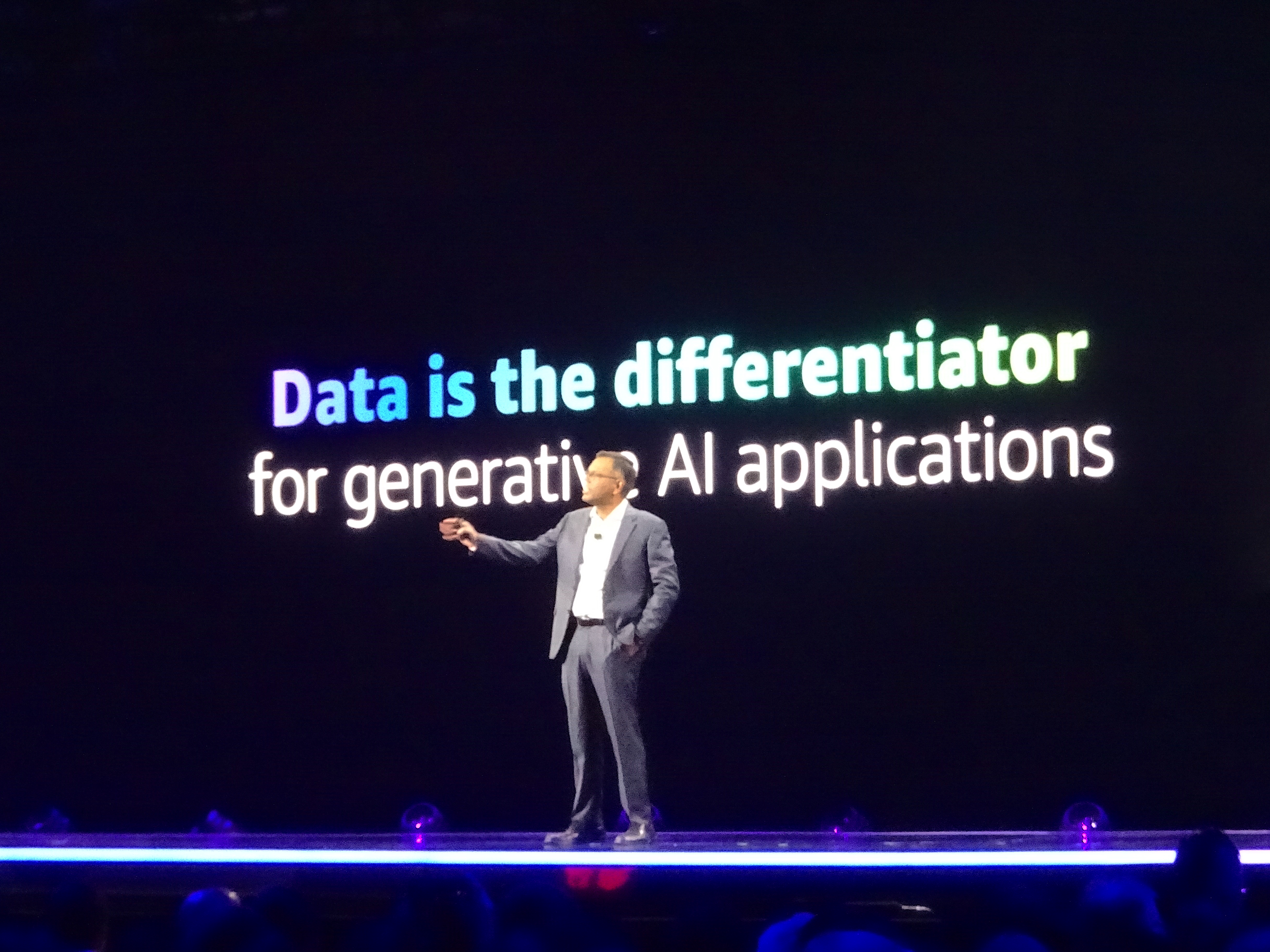 CLOUD
CLOUD
 CLOUD
CLOUD
 CLOUD
CLOUD
After outlining its parameters for the “Generative AI stack” on Tuesday, Amazon Web Services Inc. today unveiled key services and tools to realize that vision at the company’s re:Invent gathering in Las Vegas.
In his keynote remarks to announce the latest set of offerings, Swami Sivasubramanian (pictured), vice president of data and AI at AWS, drew a comparison between generative artificial intelligence and a “beautiful explosion of energy called a supernova” to describe the current AI focus in the technology world.
“A powerful relationship between humans and technology is unfolding before all of us,” Sivasubramanian said during his re:Invent presentation today. “I like to think of what’s happening today as a beneficial relationship between data, generative AI and humans.”
That beneficial relationship will depend on AWS’ ability to support its enterprise customers, driven by the need for a structure to implement generative AI. From the cloud giant’s perspective, this will include access to foundation models, a private environment to leverage data, easy-to-use tools to build and deploy applications, and purpose-built machine learning infrastructure.
As defined by today’s releases, that structure will rely significantly on SageMaker, the company’s machine learning platform, along with the newly unveiled Amazon Q generative AI-powered assistant. Amazon Bedrock, the company’s service for making foundation models available through API, has also been positioned as a significant resource.
For SageMaker, AWS announced HyperPod, a solution designed to remove the undifferentiated heavy lifting involved in optimizing machine learning infrastructure for model training. The company has claimed that the new offering reduces the time to train models by up to 40%
“This one is a big deal,” Sivasubramanian said. “Customers will see dramatic improvements.”
The significance of HyperPod can be found in its ability to address the limitations of information technology infrastructure in handling the volume of data and complexity required to train models. This has often involved splitting model training across hundreds or thousands of accelerators and running trillions of data computations in parallel for weeks or months.
SageMaker HyperPod enables customers to automatically split training workloads across compute resources and periodically save checkpoints to avoid lost time if one component fails.
“Think of it as a traffic management problem,” Ankur Mehrotra, director and general manager of Amazon SageMaker, said in an exclusive interview with SiliconANGLE. “It optimizes communication between the GPUs. It gives customers self-healing training clusters.”
Building on its major announcement this week of the Amazon Q generative AI assistant, AWS added to the offering with generative SQL in Redshift to simplify query authoring, and a data integration feature in the serverless AWS Glue platform using natural language.
“Q supports virtually every area of your business by connecting to your data,” Sivasubramanian said. “AI can enhance the data foundation that fuels it. We can use this technology to address some of the big challenges in data management.”
Amazon Bedrock has figured prominently in the cloud giant’s announcements this week. It became generally available in September and AWS chief executive Adam Selipsky and Sivasubramanian both noted in their keynote remarks that Bedrock has been used by more than 10,000 customers.
The company has been steadily accumulating new features for Bedrock with a drumbeat of enhancements, including the addition of fine-tuning features and new security services on Tuesday. The focus today was to address the need for a broader choice of models, and AWS announced that it has incorporated Claude 2.1, the latest version of Anthropic Inc.’s language model, and will also add Meta Inc.’s Llama2 70B to Bedrock.
“We are still in early days with generative AI and these models will continue to evolve at accelerated speeds,” Sivasubramanian said.
Bedrock is also emerging as a useful resource in the evolving field of vector databases. Sivasubramanian noted during his remarks that a number of vector databases are tailored for Bedrock now, including Redis Enterprise Cloud and Pinecone, with MongoDB and Amazon Aurora coming to the platform soon.
AWS announced new vector search capabilities, with offerings for OpenSearch Serverless, Document DB, Dynamo DB, and Amazon MemoryDB for Redis. In a paper posted earlier this year on the AWS website, G2 Krishnamoorthy, vice president of AWS Analytics Services, Database and AI Leadership, and a number of collaborators outlined how vector data stores have the potential to play a significant role in generative AI.
Embeddings or vector elements that map semantic relationships in a database can be particularly helpful in the field of generative AI. “Vector embedding can represent this information more powerfully,” Krishnamoorthy said in an exclusive interview with SiliconANGLE. “We are very early.”
It may be early for several of the technologies that could ultimately power the AI juggernaut, but AWS has used its re:Invent showcase in Las Vegas to demonstrate its interest in having a major say in the technology’s direction.
“The powerful symbiotic relationships between data, generative AI and humans are accelerating our ability to create new innovations,” Sivasubramanian said. “AWS has everything to unlock this powerful technology.”
Support our mission to keep content open and free by engaging with theCUBE community. Join theCUBE’s Alumni Trust Network, where technology leaders connect, share intelligence and create opportunities.
Founded by tech visionaries John Furrier and Dave Vellante, SiliconANGLE Media has built a dynamic ecosystem of industry-leading digital media brands that reach 15+ million elite tech professionals. Our new proprietary theCUBE AI Video Cloud is breaking ground in audience interaction, leveraging theCUBEai.com neural network to help technology companies make data-driven decisions and stay at the forefront of industry conversations.